Make sure to install or remove sprinklers with the correct fire sprinkler head wrench!
Every tradesperson knows that doing good work starts with the right tools. And this maxim is especially true when removing or installing fire sprinklers. To help prevent damage to delicate parts, you need the correct fire sprinkler head wrench.
Sprinkler wrenches are specialized tools capable of tightly gripping a sprinkler head with significantly less chance of harming the heat-sensitive element, deflector, or other parts. Every sprinkler manufacturer makes wrenches that specifically fit their sprinklers—and every sprinkler has at least one wrench designed for it.
But fire sprinkler wrenches aren’t just the tools of professional fitters. Every facility with an automatic fire sprinkler system needs to keep fire sprinkler head wrenches, plus a stock of spare sprinklers, on-premises in a dedicated sprinkler cabinet. This code-mandated kit, which includes a list of all heads in the building, makes it possible to quickly service a sprinkler system after a head activates or gets damaged.
This article is your guide to fire sprinkler wrenches, including:
- The NFPA 25 rules for keeping wrenches and spare sprinklers on hand
- The types of fire sprinkler head wrenches
- How to use the SIN to select the right fire sprinkler head wrench
- And a review of:
- Purchasing compatible wrenches, the easy way
QRFS carries all the wrenches from major manufacturers, helping you stay ready for your next inspection. Make sure you have the spare sprinkler cabinet, spare fire sprinklers, and wrenches needed to maintain your system and remain compliant.
Use the QRFS Quick Finder app to look up the parts you need!
The NFPA 25 rules for keeping wrenches and spare sprinklers on hand
Every facility with fire sprinklers should be ready to replace them. Nonfunctional heads might mean a system is “impaired” or a portion of it is. This could require a building shutdown, closed-off sections, a fire watch, or other measures, depending on the authority having jurisdiction (AHJ) and specific code requirements.
So, NFPA 25: Standard for the Inspection, Testing, and Maintenance of Water-Based Fire Protection Systems requires a ‘repair kit’ to be kept on hand. This is called the spare sprinkler cabinet.
The exact number of sprinklers you need depends on how many are installed (2023 edition: 5.4.1.6.4):
- Less than 300 sprinklers installed: at least 6 spares needed
- Between 300 and 1,000 installed: at least 12 spares needed
- Over 1,000 installed: at least 24 spares needed
The standard says “at least” because you might need more. This cabinet should contain extra sprinkler heads representing all types of sprinklers in the system. Sprinkler type refers to the core features of the sprinkler—is it upright, pendent, or sidewall? Extended coverage? Standard or quick response? The list can go on, depending on the size and complexity of the system.
Ultimately, every model has a unique sprinkler identification number, aka SIN. The cabinet should also include spares for all activation temperatures of the sprinklers on the property (5.4.1.6.1). Covering all the types and temperature combinations can add up to more than the minimum number.
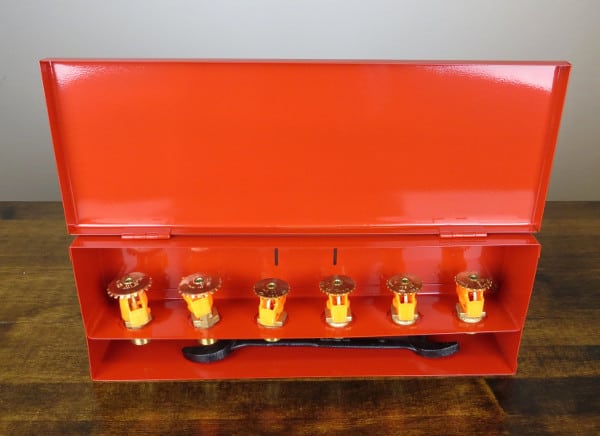
Besides the required spare sprinklers, NFPA 25 also requires you to keep the fire sprinkler wrenches necessary to remove and install all heads on the property (5.4.1.6.5). Some facilities only need one wrench—and note that manufacturers often have ones that cover several sprinkler types.
But large facilities with many sprinklers often need multiple wrenches.
For more information, check out our guide: “Fire Sprinkler Head Replacement Cabinet: How to Make a Sprinkler Kit.”
The types of fire sprinkler head wrenches
Again, fire sprinkler wrenches are designed by manufacturers to fit certain fire sprinkler heads. As Viking points out, using the proper tool provides a good grip and leverage to prevent slippage.
You’ll make the work harder if you use the wrong wrench (including something like a standard adjustable crescent). Moreover, you could damage the delicate heat-sensitive element or other parts and void the warranty.
Generally, manufacturers offer two different styles of wrenches. The first is the standard wrench with an integrated handle. They look like regular crescent wrenches and are useful for installing or removing exposed/surface-mounted sprinklers. Sometimes, the handles of these wrenches are bent/zigzagged to make it possible to install recessed sprinklers.
Manufacturers also offer a socket-style wrench for many recessed and all concealed sprinklers. These are very handy, and most are used in conjunction with regular ratchet wrenches. The socket design enables a good fit into a recessed sprinkler’s escutcheon or a concealed sprinkler’s cup.
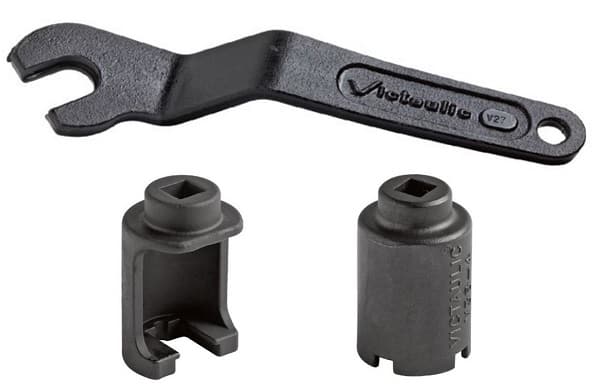
Some manufacturers also produce “light duty” or “cabinet” versions of the wrenches for their most-used sprinklers. Often made of plastic instead of steel, these wrenches aren’t meant for daily use. But they can satisfy the NFPA requirements at a lower cost than a contractor’s tool.

Manufacturers typically offer a few wrenches that cover many similarly designed sprinkler heads. For example, one that fits one pendent sprinkler will probably also fit the sidewall and upright versions and maybe other models.
But you’ve got to be sure—and here’s how to do it.
How to use the SIN to select the right fire sprinkler head wrench
There’s no guesswork involved in picking the correct sprinkler wrench—the manufacturer tells you which one to use. You simply need to identify your sprinkler’s SIN so you can reference the valid data sheet.
As we mentioned earlier, every sprinkler has an identifier called a SIN. SINs are five-to-six-digit (rarely, seven-digit) alphanumeric codes printed on the deflector plate of every sprinkler manufactured after 2000.
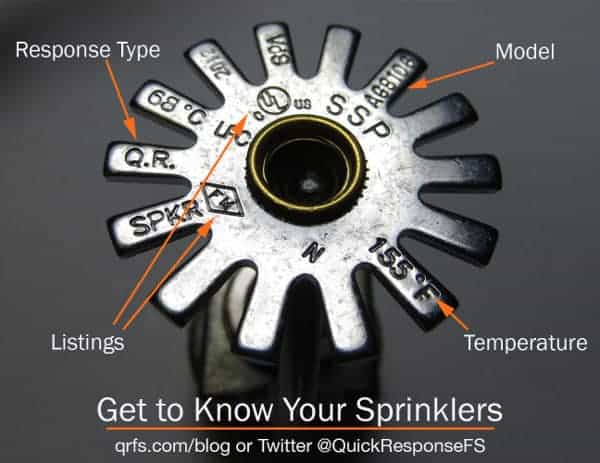
The letters at the beginning of the SIN indicate the manufacturer—like TY for Tyco, R for Reliable, VK for Viking, V for Victaulic, and SS for Senju. The numbers indicate the unique sprinkler model.
Besides finding the SINs stamped on deflectors, these identifiers for every sprinkler should also be listed in your documentation for the system. A list should be kept in the sprinkler cabinet. If that fails, the original plans for the system record the different sprinkler heads.
Suppose this information isn’t handy and your sprinklers are old. In that case, the process can become a lot more complex, as some older models have a variety of distinguishing marks and characteristics—some of which can only be seen if you remove the head and look at it.
Obviously, this is a problem if you don’t have the wrench to remove them. For a guide on IDing mysterious fire sprinklers, read our previous piece: “Which Fire Sprinkler Do I Have? And How Do I Replace It?” QRFS also regularly helps our customers ID antiquated sprinklers.
Once you have the sprinkler’s SIN or otherwise determine the exact make and model, you can do an online search or look on a QRFS product page to find the manufacturer’s data sheet for the sprinkler. This document lists the proper wrench or wrenches.
But you can also try QRFS’s Quick Finder app—just plug in your SIN to find any compatible sprinkler wrenches (or replacement sprinklers, cover plates, and escutcheons) in our online inventory.
A review of Viking fire sprinkler head wrenches
Viking offers many different wrenches for its sprinklers, frequently giving you a choice of socket or standard models. You can browse the selection on our website.
Among Viking’s standard wrenches, a few models cover most cases. Model 21475M/B installs most of the older Model M sprinklers, while the 23559MB wrench handles most non-concealed XT-1 sprinklers. Note that Viking updated the shape of its XT-1 wrench bosses for easier installation. So, if you have the older style XT-1, you need the older style wrenches—likely the 22927MR.
For recessed and concealed sprinklers, Viking has an extensive number of socket wrenches. The main XT-1 socket is 23560MB (or 20951M/B if you have the old-style frame).
Many Viking wrenches are available as light-duty “cabinet” versions. Again, these less expensive wrenches, sometimes but not always made of plastic, are suitable for keeping on hand as required spares but not necessarily for daily installations by contractors.
Viking also has a special socket (24339) that can install some concealed XT-1 sprinklers with their protective caps in place—a major labor-saving feature. Read more about this benefit here, or check out this video demonstration:
Victaulic fire sprinkler head wrenches
Victaulic’s hardware catalog is highly focused, so it can offer only a few wrench options to service the entire line of FireLock brand sprinklers. Browse different models on our website.
Victaulic groups their sprinklers by the first three digits of their SINs: V27, V29, and so on. These correspond to what Victaulic calls “frame styles.” The company’s wrenches are mostly named for the frame style they fit (though the categories don’t always match perfectly).

There are two notable things about Victaulic’s wrenches. First, it is the only company offering t-handle sockets (part numbers V38-5 and V29-1). These sockets don’t need separate ratchets.

Second, some of Victaulic’s sprinklers (V28, V42, V56, V11, and V81) are installed with standard crescent wrenches, either ½” or ¾,” depending on the model. There are no special tools for these sprinklers.
Reliable fire sprinkler wrenches
Because Reliable has such an extensive catalog of fire sprinklers for all sorts of applications, its list of wrenches is equally long. You can browse Reliable’s core wrenches on our website. If you don’t find the tool you need, contact our customer service team, and we’ll help you get it.
Reliable wrenches are either standard models for upright or non-recessed heads or sockets for recessed and concealed sprinklers.
Senju fire sprinkler wrenches
Senju is best known for its unique selection of concealed and flush sprinklers and its paint and finish customization options. So, it makes sense that most of this manufacturer’s wrenches are sockets capable of installing concealed, flush, and recessed sprinklers. Senju also has some standard wrenches for its line of non-concealed non-flush sprinklers. Browse Senju’s wrenches on our website.
Among the sockets, Senju has two helpful features available. First, some wrenches come in light-duty plastic formats that are good for keeping in sprinkler cabinets. The RC Plastic concealed sprinkler wrench is one example. Second, like Viking, some of Senju’s tools (like the NR-H concealed residential wrench) install concealed sprinklers with the caps in place.
Tyco fire sprinkler head wrenches
Tyco, now owned by Johnson Controls, sells many different sprinkler models. So, its list of sprinkler wrenches is also enormous. This is partly because Tyco acquired many now-defunct sprinkler companies, making them the vendor for obscure tools and sprinklers.
You’ll probably need to buy a wrench from Tyco to service certain Grinnell, Gem, or Star sprinklers. Our website lists the most used tools. Specifically, the standard wrench W-Type 6 and the socket W-Type 7 cover the bulk of their sprinkler catalog.
A distinctive feature of Tyco wrenches is that their standard tools are two-sided, with each side fitting a different category of sprinkler. This can help cut down on the number of tools needed to keep in a cabinet or toolkit.
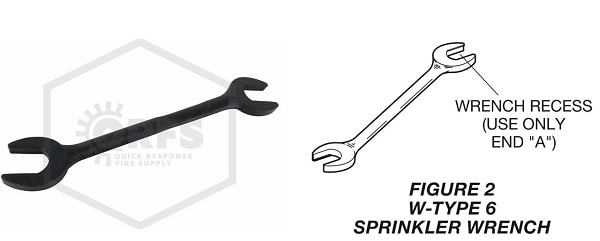
Purchasing compatible fire protection tools and equipment, the easy way
Whether you’re a sprinkler fitter prepping for your next installation or a facilities manager getting ready for an inspection, having compatible sprinkler wrenches is essential. Remember, there’s no guesswork involved in picking the right parts and tools.
Browse the QRFS catalog of sprinkler wrenches today. We have them for all the major manufacturers, including:
Or you can just plug your sprinkler SIN into our new QRFS Quick Finder app.
You’ll get the compatible wrenches (and escutcheons, cover plates, and more) in our inventory.
If you don’t find what you need, contact us, and our customer service team will assist.
This blog was originally posted at QRFS.com/blog. If this article helped you, check us out at Facebook.com/QuickResponseFireSupply or on Twitter @QuickResponseFS.


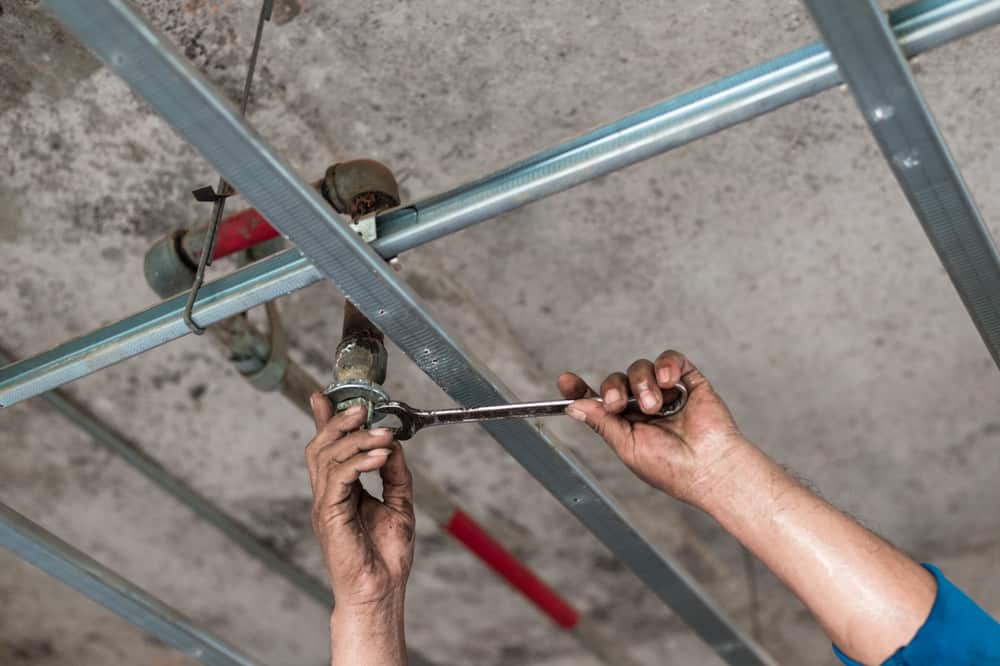
just wondering why you didn’t include the head wrenches for the older style of heads like star and globe? doing inspections myself i always find it quite hard to find the appropriate wrench for these heads. do you know if any of the newer models work for these older type sprinklers?
Holly, thanks for reaching out. The older style head wrenches were discontinued as sprinkler manufacturers developed new sprinklers. Depending on the model of sprinkler, the manufacturer may have developed compatible wrenches. Check out our sprinkler wrenches for more information on which wrench is compatible with which sprinkler.